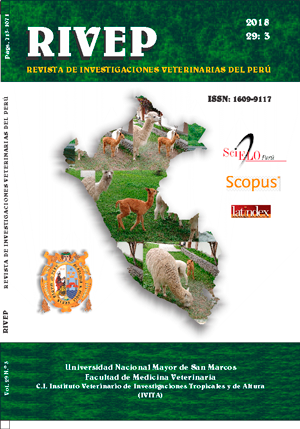The salinomycin/nicarbazin combination as anticoccidial in broilers
DOI:
https://doi.org/10.15381/rivep.v29i3.14759Keywords:
salinomycin, nicarbazin, coccidiosis, productive parameters, broilersAbstract
The efficacy in the control of coccidiosis of the anticoccidial combination of salinomycin / nicarbazin, supplied in the feed at a dose of 40 ppm, was evaluated through changes in productive parameters in broilers challenged experimentally with local strainsof coccidia and raised up to 42 days of age. Broilers of the Cobb Vantress 500 line (n=450) were distributed into three experimental groups with 6 repetitions of 25 birds each. G1: chicks not challenged and treated with the anticoccidial combination, G2: chicks challenged and treated with the anticoccidial combination, and G3: chicks challenged and untreated. Body weight, body weight gain, feed consumption, feed conversion index, European productive efficiency index and the viability were determined. Broilers of groups G2 and G3 were challenged at 14 days with 1 ml of coccidia inoculum containing sporulated oocysts of Eimeria acervulina (105), E. maxima (3x102) and E. tenella (104). Results showed body weight: 2650.4, 2431.6 and 2111.6 g; accumulated weight gain: 2604.1, 2384.0 and 2063.8 g; feed conversion: 1.53, 1.61 and 1.65; and productive efficiency index: 408.67, 355.94 and 282.00 for G1, G2 and G3, respectively. All values showed significant differences (p<0.05). A lower but not significative percentage of viability was observed in G3 (median 94%) as compared to G1 and G2 (median 100%). It is concluded that the anticoccidial combination (salinomycin / nicarbazine) was effective in the control of coccidiosis as better productive parameters were obtained in the treated groups.
Downloads
Downloads
Published
Issue
Section
License
Copyright (c) 2018 Casandra Zavala D., Eliana Icochea D., Nelly Cribillero C., Daniel Molina M.

This work is licensed under a Creative Commons Attribution-NonCommercial-ShareAlike 4.0 International License.
AUTHORS RETAIN THEIR RIGHTS:
a. Authors retain their trade mark rights and patent, and also on any process or procedure described in the article.
b. Authors retain their right to share, copy, distribute, perform and publicly communicate their article (eg, to place their article in an institutional repository or publish it in a book), with an acknowledgment of its initial publication in the Revista de Investigaciones Veterinarias del Perú (RIVEP).
c. Authors retain theirs right to make a subsequent publication of their work, to use the article or any part thereof (eg a compilation of his papers, lecture notes, thesis, or a book), always indicating the source of publication (the originator of the work, journal, volume, number and date).



